| Author |
Message |
Randall Moffett

|
 Posted: Tue 13 Jul, 2010 5:01 pm Post subject: Posted: Tue 13 Jul, 2010 5:01 pm Post subject: |
 |
|
Thom,
It could also be personal preference, regional or cultural tastes, etc. whether one had a padded liner or padded under garment. There is no reason both could not have been used at the same time (not by the same person per se).
RPM
|
|
  |
 |
Thom R.

|
 Posted: Tue 13 Jul, 2010 9:36 pm Post subject: Posted: Tue 13 Jul, 2010 9:36 pm Post subject: |
 |
|
I interrupt this program to make a brief announcement
Thomas R. and myself are two different people ( I did not change my avatar).
Please do not send me PMs regarding posts by Thomas R. 
thank you and I return you to your regularly scheduled debate on historical mail 
PS jazerant was definitely in use in western Europe. We have written references for it. I don't understand why anyone could claim that mail was not sewn to cloth or into clothing at times during the high medieval period. We know that it was done.
|
|
  |
 |
Chad Arnow
myArmoury Team


|
 Posted: Wed 14 Jul, 2010 6:09 am Post subject: Posted: Wed 14 Jul, 2010 6:09 am Post subject: |
 |
|
| Thomas R. wrote: |
First of all the hauberk was made of one single piece: coif and mittens attached. |
Aren't there illustrations of separate coifs in the 13th century? I thought the Maciejowski Bible had some and other sources do as well, if I'm not mistaken. Ditto with mittens.
I think it may be safe to say that the integrated/all-in-one seems to be the norm based on period art, but I don't think it's safe to imply (much less state) that they all were. 

ChadA
http://chadarnow.com/
|
|
    |
 |
Sander Marechal

|
 Posted: Wed 14 Jul, 2010 6:22 am Post subject: Posted: Wed 14 Jul, 2010 6:22 am Post subject: |
 |
|
| Chad Arnow wrote: | | Aren't there illustrations of separate coifs in the 13th century? I thought the Maciejowski Bible had some and other sources do as well, if I'm not mistaken. Ditto with mittens. |
There's an interesting image from the Codex Manesse. See the attachment to this post. It shows a soldier with a gambeson wearing a separate coif and maille gauntlets. No hauberk.
|
|
    |
 |
Chad Arnow
myArmoury Team


|
 Posted: Wed 14 Jul, 2010 6:25 am Post subject: Posted: Wed 14 Jul, 2010 6:25 am Post subject: |
 |
|
| Sander Marechal wrote: |
There's an interesting image from the Codex Manesse. See the attachment to this post. It shows a soldier with a gambeson wearing a separate coif and maille gauntlets. No hauberk. |
The Manesse Codex is 14th century, when separate pieces seems to have been more common. 

ChadA
http://chadarnow.com/
|
|
    |
 |
Thomas R.

|
 Posted: Wed 14 Jul, 2010 6:45 am Post subject: Posted: Wed 14 Jul, 2010 6:45 am Post subject: |
 |
|
| Chad Arnow wrote: | | Thomas R. wrote: |
First of all the hauberk was made of one single piece: coif and mittens attached. |
Aren't there illustrations of separate coifs in the 13th century? I thought the Maciejowski Bible had some and other sources do as well, if I'm not mistaken. Ditto with mittens.
I think it may be safe to say that the integrated/all-in-one seems to be the norm based on period art, but I don't think it's safe to imply (much less state) that they all were.  |
Hi Chad,
I would be very happy if you have found pictorial evidence in the Morgan Bible of any separately worn coifs. Because this would legitimate my reenactment coif for my timeline. All I have found going through the folios were some hauberks apparently without attached coif or without mittens. I have not spotted any separate coifs there. The Codex Manesse shows both: separate coifs and mittens, but it's made in early 14th century, as you did point out. Some experts declare the artists, who made the manesse, did use "oldfashioned" gear and garments to display the bards, because a lot of them were already dead by the time of the manesse makers. This interpretation would at least allow separate mailpieces at the end of 13th century.
Regards,
Thomas
http://maerenundlobebaeren.tumblr.com/
|
|
   |
 |
Sander Marechal

|
 Posted: Wed 14 Jul, 2010 7:08 am Post subject: Posted: Wed 14 Jul, 2010 7:08 am Post subject: |
 |
|
Alright then. I paged through the entire Maciejowski bible. No images of separate coifs (or gauntlets for that matter). But I did come across this statue on the Angouleme Cathedral in France (~1100) showing a separate coif with a round bottom. Yeah, I know. Still not 13th century  But interesting nonetheless. But interesting nonetheless.
 Attachment: 37.27 KB Attachment: 37.27 KB
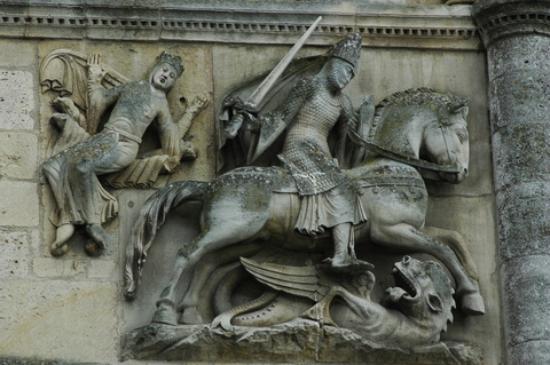
 Attachment: 172.77 KB Attachment: 172.77 KB
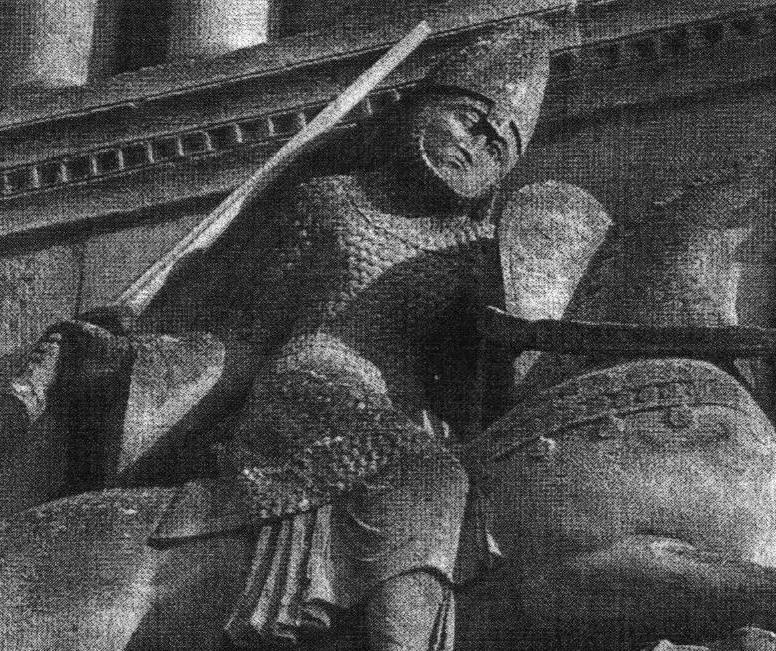
|
|
    |
 |
Sander Marechal

|
|
    |
 |
Thomas R.

|
 Posted: Wed 14 Jul, 2010 11:05 am Post subject: Posted: Wed 14 Jul, 2010 11:05 am Post subject: |
 |
|
Those pictures are good news to me, Sander!
I admit, I haven't studied such effigies and tombs until now. I concentrated on medieaval illuminations like the Morgan Bible and Codex Manesse etc. Sometimes such tombs were replaced or erected long after the death of the shown knight (or renewed in a then favourable contemporary fashion). I've seen such a later made effigy on the Wartburg Castle, where a knight who supposedly died in mid 13th century was depicted with a breastplate (but maybe the accompanying text was false? Because this armor should not have existed yet back then). So they are not always what they appear to be.
I am posting this knight's picture nevertheless, because it shows another form of ventail on a separate chainmail. So it may be of use to us.
 Attachment: 22.98 KB Attachment: 22.98 KB
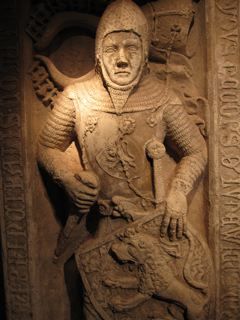
Note how the arms and armor are chained to the breastplate.
http://maerenundlobebaeren.tumblr.com/
|
|
   |
 |
Sander Marechal

|
|
    |
 |
Thomas R.

|
 Posted: Wed 14 Jul, 2010 2:08 pm Post subject: Posted: Wed 14 Jul, 2010 2:08 pm Post subject: |
 |
|
These effigies make me wonder:
a. if the armor shown in the Morgan Bible was somehow outdated, too.
b. or if the separate coif was an english or german custom, while french knights relied on the one-piece maille a bit longer.
Perhaps Randall knows?
edit: Well, I just spotted, that most of the effigies are ten or more years younger than the Morgan Bible. So perhaps we can witness here the evolution of maille chiseled in stone.
http://maerenundlobebaeren.tumblr.com/
|
|
   |
 |
Sander Marechal

|
 Posted: Wed 14 Jul, 2010 2:52 pm Post subject: Posted: Wed 14 Jul, 2010 2:52 pm Post subject: |
 |
|
| Thomas R. wrote: | | or if the separate coif was an english or german custom, while french knights relied on the one-piece maille a bit longer. |
Searching some more, specifically for French effigies:
Gilles de Fontaine (1250)
Guillaume de Poissy (1250)
Also, we don't know that all the other illuminations and effigies do not show separate coifs. I can entirely imagine a square bottomed coif like the one from St. Maurice being laced to the hauberk, and the surcoat being worn on top. You wouldn't be able to tell it's a separate coif.
In fact, that's exactly what I am planning to do myself.
|
|
    |
 |
Chuck Russell

|
 Posted: Wed 14 Jul, 2010 3:50 pm Post subject: Posted: Wed 14 Jul, 2010 3:50 pm Post subject: |
 |
|
| Sander Marechal wrote: | Alright then. I paged through the entire Maciejowski bible. No images of separate coifs (or gauntlets for that matter). But I did come across this statue on the Angouleme Cathedral in France (~1100) showing a separate coif with a round bottom. Yeah, I know. Still not 13th century  But interesting nonetheless. But interesting nonetheless. |
we looked at this piece too while doing living history. this part was indeed not a part of the original piece but added on much later than the other 13thc works. don't hold me to it, it was glen kyle that had told me that bit
|
|
    |
 |
Elling Polden

|
 Posted: Thu 15 Jul, 2010 8:39 am Post subject: Posted: Thu 15 Jul, 2010 8:39 am Post subject: |
 |
|
There are sources on separete coifs in the 13th c. However, the dominant AESTETIC is integrated coifs.Practicaly speaking this means that coifs where put on before the hauberk, to give the impression of a single piece, and keep it in place. (One early norwegian reference to loose coifs relates how a heavily armoured man is killed his foe pulls his coif up from his hauberk and stabbs him in the throath.)
This does not mean that some preferd to wear theirs on the outside of the surcote. It was just not fashionable.
Once you have an aventail that is attatched to a helmet, stuffing it into the sucote becomes impractical, and instead you make it larger to avoid thrusts from slipping under it. This again changes the asestetic, so that mail covering the shoulders becomes "cool".
This is comparable to the varieties seen in modern day soldiers under field conditions. Fads, fashions and regulations combine to produce different looks with what is essentially the same equipment.
As reenactors, I feel that we should try to stick to the prevailing "fashion" of our periods, as well as beeing aware of the variations. This discussion, for instance, will give us a lot more insight into mail coifs, changing fashions, and practical aspects of head protection. If we all where to start wearing our coifs over the surcote, however, this would not give a better impression of the epoc. On the other hand, it's no disaster if we forget to put the coif on before the hauberk...
Btw; after scourging my groups online fotos, I finally found a good shot of my collar;
 Attachment: 62.33 KB Attachment: 62.33 KB
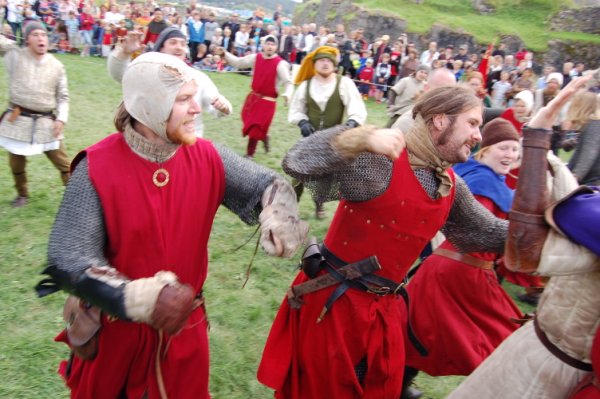
A disturbingly beardless me, during a warm-up rugby game... A more moderate, standing collar version can be seen on my coleague on the left.
"this [fight] looks curious, almost like a game. See, they are looking around them before they fall, to find a dry spot to fall on, or they are falling on their shields. Can you see blood on their cloths and weapons? No. This must be trickery."
-Reidar Sendeman, from King Sverre's Saga, 1201
|
|
    |
 |
Randall Moffett

|
 Posted: Thu 15 Jul, 2010 3:25 pm Post subject: Posted: Thu 15 Jul, 2010 3:25 pm Post subject: |
 |
|
Thom,
There has been some evidence that the Mac bible was supposed to show somewhat outdated armour for the c.1250 date it was done. I am not sure if I feel it is all that old fashioned though. I figure the change was likely starting around this time. It seems by the last few decades that mail coifs are becoming more and more common in text. I am sure regional preferences play a part in the speed of transfer of a new trend but it is hard to say. I could only find coifs showing up around 1290, but it was very limited in scope.
Since the Manasse codex was started, early, early 14th this makes me think it fair game for late 13th. My guess is it shows items that were decades old by that time.
RPM
|
|
  |
 |
Elling Polden

|
 Posted: Thu 15 Jul, 2010 4:25 pm Post subject: Posted: Thu 15 Jul, 2010 4:25 pm Post subject: |
 |
|
Codex Manesse, while beeing early 14th c, is something of an oddity. First of all, it is a secular work, containing chivalric songs. Second, its depictions of the various minstrells (the drawings are introductions to that minstrel's section in the book) seems to be the medevial version of a MTV rap documentary...
Everyone is depicted in extremely flashy clothes, EVERYTHING, including the horse coverings, is fur lined, and the coat-of-arms to helmet decoration trend is taken to the extreme.
My guess is that the illustrators wanted to depcit as blinged up noblemen as he could. As such I would hardly think the depictions are old fashioned. However, the illustrators might not have been very knowledgable about the cutting edge of miitary technology...
As for Maciowsky/Morgan, the illustrations are quite in line with other texts from the mid 13th century. However, the "bad guys" are often depicted with spanghelms and round shields. Spanghelms would be old fashioned for the 13th c. but not unheard of. Round shields for cavalry use would date back to the 10th century, so this is probably due to descriptions of 13th century islamic warriors, with their spanghelms and domed shields, rather than old european gear.
The shift in armour styles seems to have started with the coat of plates and knee protectors around 1250. Around 1275 ailettes came into use, followed by the sugar loaf greathelm in the 1280-90s. By 1300-1325 greaves and shin guards where starting to appear, followed by the breastplate sometime in the second quarter of the 14th c...
Over all, the 14th c. has the most drastic develoment in both miitary equipment and civilian fashion in entire middle ages.
"this [fight] looks curious, almost like a game. See, they are looking around them before they fall, to find a dry spot to fall on, or they are falling on their shields. Can you see blood on their cloths and weapons? No. This must be trickery."
-Reidar Sendeman, from King Sverre's Saga, 1201
|
|
    |
 |
|
Sam Gordon Campbell
Location: Australia. Joined: 16 Nov 2008
Posts: 678
|
 Posted: Thu 15 Jul, 2010 8:14 pm Post subject: Posted: Thu 15 Jul, 2010 8:14 pm Post subject: |
 |
|
Elling, I'm not much into sports, but if that's how you lot play rugbyover there, you can count me in! 
Member of Australia's Stoccata School of Defence since 2008.
Host of Crash Course HEMA.
Founder of The Van Dieman's Land Stage Gladiators.
|
|
  |
 |
Thomas R.

|
 Posted: Thu 15 Jul, 2010 11:47 pm Post subject: Posted: Thu 15 Jul, 2010 11:47 pm Post subject: |
 |
|
| Randall Moffett wrote: | Thom,
There has been some evidence that the Mac bible was supposed to show somewhat outdated armour for the c.1250 date it was done. I am not sure if I feel it is all that old fashioned though. I figure the change was likely starting around this time. It seems by the last few decades that mail coifs are becoming more and more common in text. I am sure regional preferences play a part in the speed of transfer of a new trend but it is hard to say. I could only find coifs showing up around 1290, but it was very limited in scope.
Since the Manasse codex was started, early, early 14th this makes me think it fair game for late 13th. My guess is it shows items that were decades old by that time.
RPM |
Randall, I agree with your observations. I think our main problem is, that we are not able to really understand, that 1250 is _not_ like 1275. That much time was passing in between and customs and fashions shifted like they do nowadays. We can't catch the feeling we call Zeitgeist in germany. Let's look back at our own last 25 years: In mid eighties cable tv was not that common in germany. In the mid nineties almost every household had it. By the end of the nineties internet and flatrates were a totally new thing, only geeks would have this rather expensive technology. Nowadays it's standard. Almost every family is online (not to speak about the evolution of the cellulars and mobile communication). So the same process is applicable to the evolvement of chainmail and coifs, but we are not that aware of it, because we haven't the insight into this timeperiod as we have it for nowadays. (And note, how different the evolution speed of communication and cable tv between the US and Germany has been. So these are regional processes as well.)
Regards Thomas
http://maerenundlobebaeren.tumblr.com/
|
|
   |
 |
Randall Moffett

|
 Posted: Fri 16 Jul, 2010 7:17 am Post subject: Posted: Fri 16 Jul, 2010 7:17 am Post subject: |
 |
|
Elling,
Still think what I thought before. If it was finished in 1304, it likely is a better idea of what was worn in the last decade or two of the 13th. One of the somewhat outdated features if I remember correctly is floor length surcoats that many of the knights and nobles are wearing. It is rare even in the HRE to see that long of surcoats in the late 13th, let alone the 14th.
I think that by the last decade of the the 13th most rigid armours, both for the torso and the limbs had been created. Gauntlets, rerebraces, vambraces, greaves, etc. all show up in various documents. A good idea of a late 13th lord would be from Ralph de Nesle's inventory. He dies in 1302 so technically very early 14th but the likelihood he bought much/most of it during the year and a half he lived of the 14th is unlikely. We also have royal accounts in England and France that show that these armours were making their ascent. In reality I'd suspect that by 1300 most upper tier nobles in Western Europe had added and were adding rigid and plate armours very often. It took some time to hit the knightly class perhaps but a few decades later, maybe by 1320-1330 it has become fairly common for them as well and by 1330 you see commoners being required to own certain plate armours.
I agree that we should try showing what was common in what social group we recreate but I'd focus on text over artwork to know when it starts in use and artwork to see how these things looked and were designed.
RPM
|
|
  |
 |
Elling Polden

|
 Posted: Sat 17 Jul, 2010 5:44 pm Post subject: Posted: Sat 17 Jul, 2010 5:44 pm Post subject: |
 |
|
Randall: The long surcotes are probably a ressult of the mentioned pimp-factor, mimicing civilian noble wear. However, our conclusions seem to be pretty much the same, namely that Manesse isn't a very good source for a accurate portrayal of ca 1300 military technology (though your angle is that it is old fashioned, and mine that it was not very realistic to begin with.)
Mac/Morgan, however, coresponds well with both the written sources and other illustrations of the time, with the eception of knee protectors. Though the coat of plates was also coming into use in this period, but these where frequently worn under the surcote or hauberk, and thus not really alter outward appearnace of the knight.
Another interesting thing at this point is that the early 13th c knightly armour allready protected against everything save a lance to the chest or heavy blows to the joints or neck; the early pieces of plate are more "patches" to the mail than preplacements. You have can find the full spectum of pieces from the 1280s, but it's rare to see someone who is wearing them all at the same time, untill you get full coverage of the limb.
But, back on track;
Wearing the coif on top of the surcote could be linked to use of a CoP or breastplate. It could also be linked to the fact that production of mail skyrocketed during the 13th c, and thus became available to more people. Or it might simply be more comfortable... (I have never worn a integrated coif, so I'm guessing)
A quite famous example of square collared coifs from SOMETIME in the 13th c. (i've seen different dates, from 1240-80)
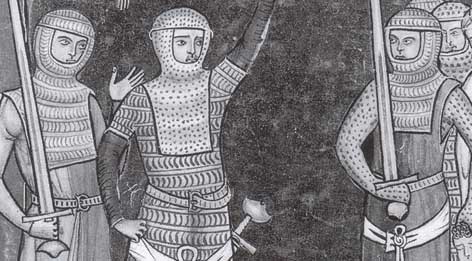
"this [fight] looks curious, almost like a game. See, they are looking around them before they fall, to find a dry spot to fall on, or they are falling on their shields. Can you see blood on their cloths and weapons? No. This must be trickery."
-Reidar Sendeman, from King Sverre's Saga, 1201
|
|
    |
 |
|
|
You cannot post new topics in this forum
You cannot reply to topics in this forum
You cannot edit your posts in this forum
You cannot delete your posts in this forum
You cannot vote in polls in this forum
You cannot attach files in this forum
You can download files in this forum
|
All contents © Copyright 2003-2024 myArmoury.com — All rights reserved
Discussion forums powered by phpBB © The phpBB Group
Switch to the Basic Low-bandwidth Version of the forum
|

